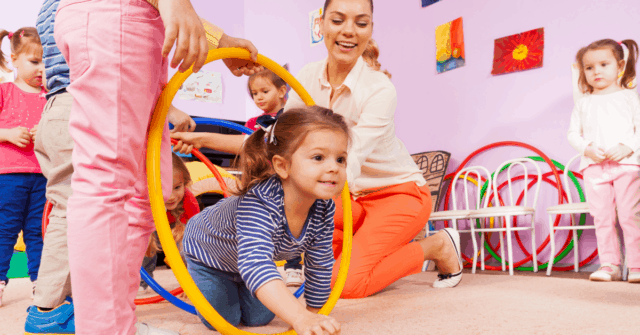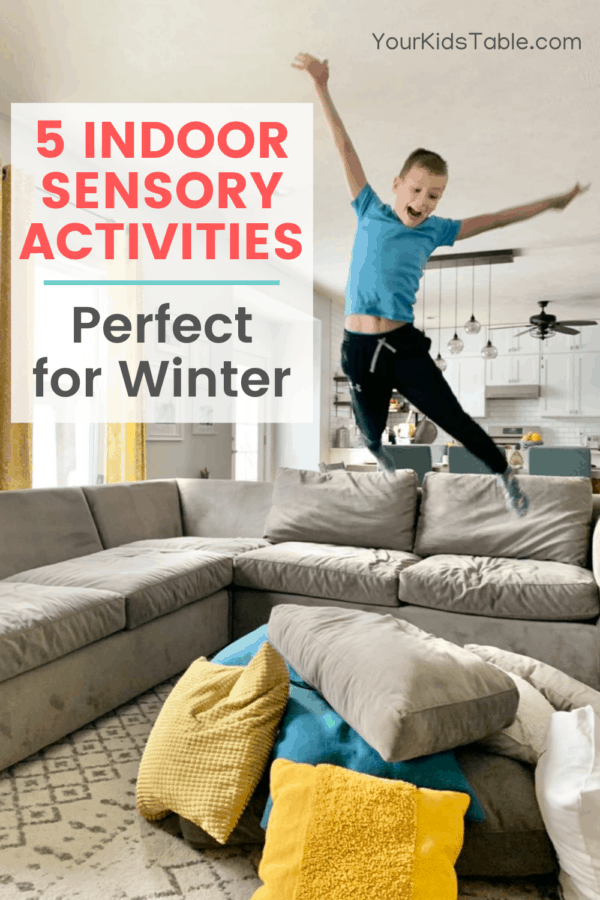Need some inspiration for fun and easy indoor sensory activities? Come check out 5 incredibly powerful sensory activities that don’t require any special equipment or supplies…
Every single season offers a unique opportunity for special sensory activities. In summer, kids run barefoot in the grass, play in the sand, and swim in the pool. In spring, kids can jump in puddles and run in the rain. In fall, piles of leaves make the best crash pad.
And, in winter, well, snow, of course.
But, sometimes it’s too cold to go outside, and your child is stuck indoors. And this year, in particular, you might not have many other outlets for activities, so in this post, I’m sharing 5 of my favorite indoor sensory activities that are perfect for cold winter days.
Does My Kid Need Sensory Activities?
Does your child really need sensory activities though? Need is a strong word.
I can tell you that ALL kids benefit from sensory activities. The stimulation to their 8 senses, yes, their 8 senses, fuels their development and learning. Plus, sensory activities often keep kids engaged and even playing independently.
Of course, kids that have sensory needs, Sensory Processing Disorder (SPD), Autism, and ADHD, likely need sensory activities. Kids with sensory needs can become dysregulated. That means their sensory system is out of balance. They understandably become fixated on seeking or avoiding sensations to get their system back into balance.
Sensory activities can be the solution to helping them gain that balance. But, various sensory activities provide different types of sensory input, so you’ll want to pay attention to what types of activities help calm and regulate your child if they have sensory needs.
5 Indoor Sensory Activities Perfect for Winter
Some of the activities you’ll find below are classic kids games to play indoors. However, I find that many of them are often forgotten about in the midst of electronics and screens. They are on this list for very good reason. Read through the descriptions to discover the specific sensory benefits of each activity.
#1: Crash into a Pillow Mountain
Set Up: Find or make a large open spot somewhere on your floor. Move the coffee table or any other small furniture if necessary. Then, grab all the couch cushions and/or throw pillows, bed pillows, and throw blankets and put them in a large pile in your open space.
Your kid will likely know what to do next, but if not show them how to climb over the pillows or to jump and crash into them. This is a memorable and fun activity that stimulates your child’s tactile, proprioceptive, and vestibular senses!
Who will it help: This is one sensory activity that nearly all kids will enjoy. Kids that love movement like active sensory seekers will think it’s Christmas morning, and kids that tend to have low energy can really become alert. If you have a child that doesn’t like movement much and is scared of swings or rough housing, make your pile of pillows small and just encourage crawling over it.
#2: Hot Chocolate Sensory Bin
Set Up: Get a large plastic storage bin, at least the size of a shoe box, but as big as an under the bed tote and fill with flour and hot chocolate. Any ratio is fine, it’s however much your have on hand or want to purchase. But, for a shoe sized bin, 7 cups of flour and 3 cups of hot chocolate would work.
You can also add 2 cups of oil to turn it into a hot chocolate cloud dough, which is a really fun texture that allows kids to make shapes that stay together.
At the same time, you could just pour in dry beans or rice and some packets of hot chocolate to get the scent. There really isn’t a wrong way to do a sensory bin. If you want some specific recipes, check these out:
Hot Chocolate Cloud Dough
Hot Chocolate Bean Bin
You may also want to include some cotton balls as marshmallows or real one’s if you don’t mind your child eating some. Add any winter toys, a wooden spoon, and a cup. Kids will often gravitate towards this activity, but if your child is hesitant, sit down and show them how to run their hands through the “hot chocolate”.
If you have a toy tea set on hand, you can “make” hot chocolate by loading up the tea cups.
Don’t ever force your child to touch the sensory bin, some kids are tactile defensive and it may be uncomfortable. Instead, demonstrate. This is a tactile or touch based activity and it may help calm your child.
Who will it help: Sensory bins are perfect for all kids as well, but as I mentioned, kids that don’t like getting messy or are tactile defensive will need to take small steps. They may need to only touch with a spoon at first. These small steps are helpful in breaking down their sensitivity though, so its important to work on it.
Children that love to get messy on the other hand, will love this activity. You may want to lay a large tablecloth down underneath you bin for easy clean up.
#3: Nighttime Hide and Seek
Set up: With nightfall coming fast in the winter, turn off all the lights once it’s dark and give you and your child a flashlight. Encourage siblings and any other adults in the house to play too. If your child is afraid of the dark, you can hide stuffed animals around the house first and then search together for them. Or, if there’s a larger group playing, team up in 2’s.
Choose somebody or a team to be the “seekers” and everyone else to be the “hiders”. After the seeker counts to 10 or 20, they turn on their flashlight and begin to search.
This classic game is elevated with sensations at night. In the dark, our hearing sense becomes more pronounced. And, for the seeker, their vision is stimulated by the bright light. Plus, hiding in cozy spaces gives lots of proprioceptive and vestibular input.
Who will it help: This is a great activity for all kids, particularly helpful for kids that need to work on following directions and visual tracking (using a flashlight in the dark targets this skill).
#4: Build a Fort
Set up: Grab a blanket and drape it over some furniture to create a quiet spot for your child to climb into. Don’t worry about making this elaborate, unless you want to. A large blanket over a kids table works perfect. Set up some pillows and books inside. A flashlight can be fun inside of a fort too. If you have any other small sensory toys around, you can put those inside as well.
This fort becomes a sensory tent, of sorts. It provides a respite from the barrage of sensations that our kids are constantly experiencing.
Who will it help: All kids benefit from a tent or fort. The child that gets overwhelmed easily can have a space to retreat to. The child that is wild and seeks movement has a place to go and calm down without distraction. The child that gets bored, is intrigued and entertained by a new space.

#5: Obstacle Course
Set up: There are a million variations of an obstacle course, many of them very simple. Any space in your home can work, but hallways are particularly great spots or around a dining room table so there’s a natural path to follow. Here’s some items you may want to include:
- Walking on a jump rope laid out of the ground
- Hopping up on or over a small step stool
- Walking on stepping stones or blocks
- Riding a scooter board on their belly
- Riding or pushing a riding toy
You can also add in stations like, “On the blue dot, do 10 jumping jacks/run in place/touch your toes/do downward dog/etc.” You and your child’s imagination is the limit here. Just aim not to make it too hard so your child gets frustrated and gives up, or make it too easy so they get bored.
Who it Will Help: This sensory activity is perfect for children that are active and have lots of energy. It funnels all that energy into something purposeful while it provides loads of vestibular and proprioceptive input.
How to Get Your Child to Engage In These Sensory Activities
Worried your child might not want to do these sensory activities? I hear you, some kids are reluctant to participate, but often, once they get going, they love it and are entertained for a long time. If you think your child won’t be interested, try these tips:
- Try having the activity totally set up and surprising them when they walk into the room.
- Don’t ask them if they want to play in a sensory bin, make an obstacle course, or any other sensory activity. Just start setting it up, and they’ll likely be very interested.
- Instead of surprising them with the activity, try telling them what you’re doing and asking for help:
- “Oh, go grab the blanket and pillow off your bed. I’m building something really cool.”
- “I’m making an obstacle course, what else should we add?”
- “Can you mix the flour and hot chocolate together? We’re going to have a fun pretend tea party!”
How Often Does My Child Need Sensory Activities?
You can use these sensory activities as often as you need them. For kids with very little or no sensory activities, once a week is great or as often as you want to. If your child has sensory needs and it interrupts their day, using sensory activities every single day can have a big impact on their attention, socialization, and learning.
Get More Sensory Activities!!
Have you grabbed our free 25 Powerful Sensory Activities to Calm and Focus Your Child printable? You’ll get 25 powerful sensory activities delivered right to your inbox for free.
Click here to get the printable!
More Sensory Activities for Kids
7 Awesome Sensory Activities Using a Yoga Ball
17 Extraordinary Sensory Activities That Help Toddlers Learn and Grow
5 Ways to Use a Scooter Board for Sensory Input
Easy Movement Break Ideas Kids Can Do at Home or School
Alisha Grogan is a licensed occupational therapist and founder of Your Kid’s Table. She has over 20 years experience with expertise in sensory processing and feeding development in babies, toddlers, and children. Alisha also has 3 boys of her own at home. Learn more about her here.

Hi! Im a teen with ADHD looking for ways to keep sensory balance through the winter. Because a lot of these tips are either for smaller kids with larger spaces, I was wondering if there any alternatives for someone whos bigger with less space? Thanks!
Thanks for reaching out! I’d check out this post full of great proprioceptive activities. You should be able to get some ideas for what might work for you!
Best,
Desiree
I live this article. As a preschool educator we run into those children who can really benefit from extra sensorial stimulation.
Awesome Erika! So glad you enjoyed!
Best,
Desiree